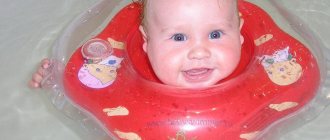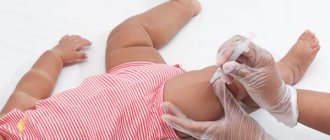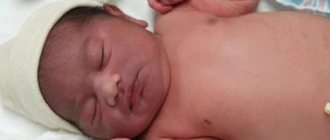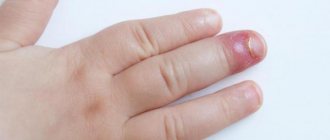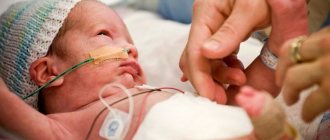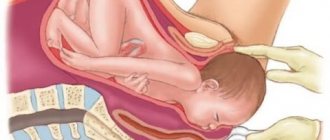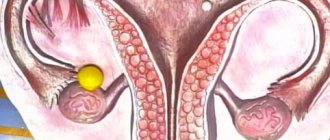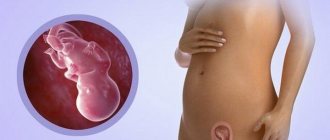How to prepare a room?
The baby should have its own well-equipped crib. For mom's convenience, it is better to install a changing table - it makes it easy to keep everything you need for changing clothes in one place. This means you don’t have to leave your baby alone to find something they need. Baby's clothes should be washed separately with special children's laundry detergents. It is recommended to iron things: after ironing they become soft, and heating the fabric is an additional disinfection.
There should be no temperature changes in the room. The ideal reading on the thermometer is 22-25 degrees.
Cloth
When buying clothes for a newborn, choose a size 3 months or larger to prevent your baby from outgrowing the clothes too quickly. Choose clothes that are soft, comfortable, and easy to wash. Choose fireproof bedding, either synthetic or specially treated cotton. Undesirable are buttons that are easy to swallow, ribbons and ribbons that can be used by a child to choke. Don't buy clothes with ties, which could get caught on something and choke your baby.
Since you will have to change your baby several times a day, at least changing diapers, choose simple clothes that are easy to take off and put on. It is better to have zippers or Velcro in the front, wide sleeves, and stretchy fabric.
In the first weeks of life, babies are often swaddled. This keeps them warmer, and the gentle pressure throughout the body makes the newborn feel calmer.
Dress for the weather. Young parents often wrap their child up too much. A good rule of thumb is to dress your baby in as many layers as you need to feel comfortable. If it is not hot, you can put a shirt, a diaper, a suit on the child and wrap him in a blanket. In hot weather - above 24 degrees - one layer of clothing is enough, but when the air conditioner is running or there is a draft, the child needs to be covered.
Remember that baby's skin burns easily. If you go outside, cover your child's skin with clothes and a hat. Keep your child in the shade. If the child is older than six months, protective equipment can be used, but do not rely on it. Babies don't sweat much and can overheat.
How to treat an umbilical wound?
In the maternity hospital, the baby is given a special brace on the remainder of the umbilical cord, and after a couple of days the remainder falls off. Usually the umbilical wound heals in 2-3 weeks. The healing process is individual, so you need to consult with your pediatrician whether it is worth treating the wound daily and which antiseptic is best to use. Whether or not to bathe a baby with an unhealed wound is up to the parents themselves, after consulting with a doctor. Many do not see any obstacles to water procedures on the first day after discharge from the hospital. But after bathing or just during the day, the child needs to have air baths so that the skin “breathes.” It is important to ensure that the navel is not pressed by the diaper. You can tuck it in or use a special one with a hole for the navel.
Newborn baby nail care
The baby's nails are soft but sharp. He can easily scratch his or your face. To avoid this, you need to cut your nails short after birth and then do it regularly every week. Sometimes you can gently pinch off the tips of your nails with your fingers as they are very soft.
Don't worry - you won't tear off the entire nail. You can use nail clippers or small scissors. Here's how to make the process easier for you and your baby:
- Trim your nails after swimming. They will be softer and easier to trim. Wait until the child falls asleep.
- Have someone hold your baby while you cut his nails.
- Cut your nails straight and short.
How to care for your skin?
The main task of the mother is to provide proper care for the newborn, and an important part of the care is maintaining clean and healthy skin. Therefore, you need to carefully examine all the folds on the baby’s skin to see if cracks or diaper rash have appeared somewhere. The baby needs to be washed after each diaper change, and it is recommended to bathe the baby every day. After all water procedures, you should lubricate with cream powder those areas of the baby’s skin where diaper rash may occur. The “My Sunshine” cream powder is ideal: the zinc oxide in its composition gently dries the skin and has an anti-inflammatory effect.
Seborrhea and dermatitis of newborns
Your baby may experience flaking and redness under the hair on the scalp. This is seborrheic dermatitis caused by excess oil production by the skin glands. This often occurs in newborns in the first weeks of life, but goes away within a few months. To a small extent it resembles dandruff. In more serious cases, thick, greasy, yellowish scales or crusts form.
Washing with baby shampoo may help. Don't be afraid to wash your child's hair more often than usual. This and gentle combing will help remove the crusts. If the crusts do not come off easily, use gel or vegetable oil. Let it absorb, then comb and wash your hair with shampoo. If the oil is not washed off, the scales will stick and the situation will only get worse.
If the peeling continues or spreads to the face, neck and other parts of the body, especially the elbows and behind the ears, consult your child's doctor to recommend a medicated shampoo or lotion.
How to care for your baby's intimate area?
During breastfeeding, you will have to wash the baby quite often - some have stool after every feeding. It is important to follow simple washing rules:
- carry out the procedure under running water, using special hypoallergenic “My Sunshine” wash products, which are suitable for repeated use throughout the day and do not dry out the skin;
- mothers of girls need to make sure that the water flows from the tummy to the butt, for boys it’s the opposite;
- You need to wash off dirt with gentle stroking movements;
- there is no need to soap and thoroughly scrub the intimate organs from the inside, so as not to injure the mucous tissues.
When walking or traveling, you can use “My Sunshine” baby wipes, which quickly and gently cleanse the skin. If your baby experiences irritation, you can use wipes with panthenol, which are suitable for especially sensitive skin. Panthenol in the composition helps to moisturize and soften delicate skin.;
Several times a week, the baby should be given a warm bath (ideal temperature is 37 degrees) with a special bathing foam. An excellent option is the “My Sunshine” foam with chamomile and string extracts, which soothe the skin. If you bathe your baby before bed, you can carry out the procedure with Bayu-bayushki foam: the soft aroma of lavender and rose oil will set your baby up for a restful and sound sleep.
How to wash your hair?
Pediatricians recommend washing your baby's head before removing him from the water. Lather a small amount of “My Sunshine” shampoo on your palm and gently lather your hair. Don't be afraid that it will get into your eyes - the shampoo does not sting. It will gently cleanse the scalp and help prevent the formation of dry crusts.
If dry crusts do appear, before bathing you can lubricate the baby’s head with baby oil, then wash the hair with mild shampoo and at the end of the water procedure, comb out the scales with a fine-toothed comb designed specifically for babies. The procedure will have to be repeated several times to get rid of the problem. Be sure to consult your doctor if scabs still appear after this.
After bathing, the baby’s hair is not wiped dry, but only lightly blotted with a towel.
How to care for your oral cavity?
The key to oral health is cleanliness. Therefore, pacifiers, bottles, and mother's breasts should be clean. All this needs to be wiped with a cotton pad before feeding. It is recommended to clean your mouth after every meal. This can be done by wrapping your finger in gauze or sterile cotton wool and moistening it with warm water. At the pharmacy you can buy a special silicone thimble with soft tubercles for more effective cleaning. Your baby will only need his own toothbrush when his teeth start cutting.
How to clean your eyes?
The baby’s morning begins with a daily procedure: the mother washes his face with a damp palm, napkins or damp cotton pads. Then he wipes the eyes with a cotton wool soaked in warm water. From the outer corners to the inner ones, be sure to clean each eye with its own disc.
How to clean your spout?
The procedure can be performed in the morning or evening after swimming, when the crusts in the nose become soft. You need to twist sterile cotton wool into a tourniquet and roll it in the right and left nostrils (each has its own turunda). Do not use cotton swabs (even with restraints). The baby's nasal passages are very narrow and can be easily injured.
How to care for your ears?
Ears should be cleaned daily using cotton swabs. Don't be afraid if water gets into your baby's ear while bathing: blot it with a cotton pad or carefully collect the water with a turunda. Droplets of moisture will come out on their own if you place the baby on its side. This can be done during feeding after a bath.
Check for cracks and diaper rash behind the ears. To eliminate irritation, redness and diaper rash, use the same cream-powder “My Sunshine”; it can be applied to any area of the baby’s skin.
Should I cut my baby's nails?
Necessarily. Children often accidentally scratch themselves with sharp nails. But remember that babies do not like this procedure. Therefore, it is better to do a manicure when the baby falls asleep. Use special children's scissors with blunt ends. The nails on the hands are cut in a circle, on the legs - in a straight line.
How to hold a baby
At first you will be nervous and awkward when holding your baby. But everything will work out. You'll soon figure out which positions your baby likes - even babies have their own preferences. Newborns usually like to be held close - they are soothed by the warmth of your body. They also feel safe when cradled on a bent arm, with their head, arms and legs held firmly.
In the first few months of life, different children have different ways of controlling their neck muscles and holding their head. While your baby is not yet able to hold his head well, lift him carefully and slowly so that his head does not tip back. When laying your baby down, gently support the head and neck with one hand and the back with the other.
Gradually you will determine which position best calms a crying baby. You can try laying it face down on your arm with the head resting on your elbow. You can place it on your tummy on your lap. You can also lie on your back, place your baby on your chest and lightly rub his back.
The child may also develop his own preferences in how it is worn. Some people prefer to face forward and look out at the world, while others feel calmer with their head against your shoulder. Some children find it more comfortable to have their arms and legs supported, while others like greater freedom when only their head and back are supported.
Mother and baby's first walk
Going outside with your baby for the first time is an important event for young parents. After all, being in the fresh air is very beneficial not only for the newborn, but also for the mother. The more you are in the fresh air, the better your blood circulation becomes, your appetite increases, and your sleep improves. While walking, the baby receives such an important vitamin as vitamin D, the lack of which can lead to a disease such as rickets.
You can go outside with your baby for the first time the very next day after arriving from the maternity hospital, provided that the air temperature outside is above 10 degrees below zero. The duration of the first walk is a maximum of 15 minutes, and each subsequent day its duration can be increased by 15 minutes. In order to understand whether a child is cold or hot, touch his palms, legs or the top of his head. If any of the above is cold, then the baby is cold, if it is wet and hot, then he is hot.
Proper feeding is the key to baby’s health
At 1 month of life, it is very important to stabilize and establish the baby’s feeding regimen, since the baby’s development directly depends on the amount of nutrients entering the body.
The first days after childbirth, colostrum is produced in the breast - the so-called harbinger of milk; such light nutrition is quite enough for a fragile body, but after 3-4 days the breasts become firmer, since full-fledged milk appears in it. At this stage, it is important to help the child develop elastic breasts, since often the newborn’s strength is not enough to suck out nutrition. You can rub the seals yourself, or you can use a breast pump.
There are situations (this is especially typical for first-time mothers) when at 1 month the mother does not have enough milk to fully feed the baby, in this case it is necessary to take measures to increase lactation as soon as possible.
- Firstly, you should put the baby to the breast as often as possible, since when it comes to producing breast milk, demand creates supply, i.e. the more often the baby sucks out the available liquid, the more of it appears next time.
- Secondly, improper attachment not only complicates the feeding process, but also interferes with the full activation of the lactation period. If a baby only grabs the nipple, he cannot suck out a sufficient amount of milk, and this method of grasping also causes a lot of anxiety and pain for the mother. Help the baby - straighten the breast, direct the nipple into the mouth so that the baby captures the entire areola, watch the position of the baby’s body, the head should be at shoulder level, and the neck should not be bent in any way, since it will be difficult for the baby to swallow.
- Thirdly, special herbal teas for pregnant women can help increase the amount of breast milk. Such products not only stimulate milk production, but also help prevent intestinal colic in a newborn.
Useful: What is the difference between diapers and diapers, which is better?
After feeding the baby, you should definitely hold him in a “column”, that is, vertically, pressing him with his tummy. This is done so that the baby can regurgitate the remaining milk, freeing the stomach from excess air that is swallowed during feeding. If this is not done, the baby may burp during sleep, which will, at best, wake up, and at worst, cause difficulty breathing.
First meeting of a newborn with relatives
So, mother and newborn baby arrived home. First of all, before approaching the baby, everyone in the house should wash their hands with soap. Since an infant sees and hears from the first minutes of his life, guests should behave quite quietly, without any loud or sharp sounds that could frighten the baby . We must not forget that after the maternity hospital, the young mother wants to get herself in order, and the father wants to take a better look at his child, so after congratulations, it is advisable for the guests to leave and leave the parents alone with their little one.
Microclimate in the house
Creating and maintaining a healthy microclimate is an important factor in proper care, both in the first and subsequent weeks of life. Wet cleaning of the apartment should be done at least once a week. Using special devices, humidity is maintained within the range of 50-70%.
In dry and hot air, the baby loses a lot of fluid. Clean, moist and cool air is necessary for health and proper care. Therefore, the room temperature is maintained at up to 22 degrees in cold weather and up to 24 degrees in warm weather. This daytime temperature is most favorable for active life and daytime sleep.
A comfortable night temperature is considered to be 19 degrees. If your baby is a light sleeper, a product such as white noise for newborns may help. A monotonous background helps the child relax and neutralizes other sounds in the home.
